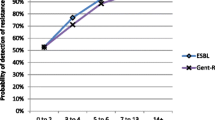Abstract
Background
The Mid-West of Ireland has higher than average national rates of invasive extended-spectrum beta-lactamase (ESBL) bloodstream infections and carbapenemase-producing Enterobacteriaceae (CPE), with increasing numbers of ESBL isolates detected in community-dwelling patients.
Aims
To conduct a point prevalence study in a convenience sample of the Mid-West population with the aim of determining the extent of ESBL colonisation.
Methods
Utilising anonymised community stool samples that had completed routine analysis, we conducted a point prevalence study over a 4-week period on all samples that met defined inclusion and exclusion criteria. Limited epidemiological data was recorded: (1) age of patient, (2) gender, and (3) sender location. From these stool specimens, rectal swabs were inoculated (eSwab™ 480CE, Copan, Italy), which were subsequently cultured on selective chromogenic agar (Colorex™ ESBL). Culture plates were incubated aerobically at 37 °C for 24 h.
Results
Of 195 samples processed, 58 % (n = 112) were from females. The median patient age was 62.4 years (range 20–94 years). 186 samples (95 %) originated from general practitioner clinics. During the study period, only nine eligible stool samples were received from LTCF (6 public). From 195 Colorex™ ESBL chromogenic agar plates cultured, no ESBL-producing organisms were detected.
Conclusions
This community point prevalence study did not identify ESBL colonisation despite high numbers of patients with invasive ESBL bloodstream infections presenting for admission in our institution. We believe this may be because of our small sample size. Data regarding antimicrobial exposure and other risk factors for ESBL colonisation were also not available. We remain vigilant for ESBL-producing organisms.

Similar content being viewed by others
References
Spellberg B, Guidos R, Gilbert D, Bradley J, Boucher HW, Scheld WM et al (2008) The epidemic of antibiotic-resistant infections: a call to action for the medical community from the Infectious Diseases Society of America. Clin Infect Dis Off Publ Infect Dis Soc Am 46(2):155–164
Irish EARS-Net Steering Group (2015) EARS-Net Report, Quarter 3 2015. Dublin 2016 [updated 19/4/16]. Available from: http://www.hpsc.ie/AZ/MicrobiologyAntimicrobialResistance/EuropeanAntimicrobialResistanceSurveillanceSystemEARSS/EARSSSurveillanceReports/2015Reports/
Pfaller MA, Segreti J (2006) Overview of the epidemiological profile and laboratory detection of extended-spectrum beta-lactamases. Clin Infect Dis Off Publ Infect Dis Soc Am 42(Suppl 4):S153–S163
Burgess DS, Hall RG 2nd (2004) In vitro killing of parenteral beta-lactams against standard and high inocula of extended-spectrum beta-lactamase and non-ESBL producing Klebsiella pneumoniae. Diagn Microbiol Infect Dis 49(1):41–46
Bonkat G, Muller G, Braissant O, Frei R, Tschudin-Suter S, Rieken M et al (2013) Increasing prevalence of ciprofloxacin resistance in extended-spectrum-beta-lactamase-producing Escherichia coli urinary isolates. World J Urol 31(6):1427–1432
Wani KA, Thakur MA, Siraj Fayaz A, Fomdia B, Gulnaz B, Maroof P (2009) Extended spectrum B-lactamase mediated resistance in Escherichia coli in a Tertiary Care Hospital. Int J Health Sci 3(2):155–163
O’Connor C, O’Connell NH, Commane M, O’Donovan E, Power L, Dunne CP (2016) Limerick: forever associated with five lines of rhyme or infamous for irrepressible carbapenemase-producing Enterobacteriaceae for all time? J Hosp Infect 93(2):155–156
Chulain MN, Murray AM, Corbett-Feeney G, Cormican M (2005) Antimicrobial resistance in E. coli associated with urinary tract infection in the west of Ireland. Ir J Med Sci 174(4):6–9
Fennell J, Vellinga A, Hanahoe B, Morris D, Boyle F, Higgins F et al (2012) Increasing prevalence of ESBL production among Irish clinical Enterobacteriaceae from 2004 to 2008: an observational study. BMC Infect Dis 12(1):1–8
Burke L, Humphreys H, Fitzgerald-Hughes D (2012) The revolving door between hospital and community: extended-spectrum beta-lactamase-producing Escherichia coli in Dublin. J Hosp Infect 81(3):192–198
O’Connell N, Keating D, Kavanagh J, Schaffer K (2015) Detection and characterization of extended-spectrum beta-lactamase-producing Enterobacteriaceae in high-risk patients in an Irish tertiary care hospital. J Hosp Infect 90(2):102–107
Knowles SJ, Jacob AM, O’Dea G (2016) Prevalence of multi-drug-resistant organism carriage in pregnant women. J Hosp Infect 93(1):68–69
Gazin M, Paasch F, Goossens H, Malhotra-Kumar S (2012) Current trends in culture-based and molecular detection of extended-spectrum-beta-lactamase-harboring and carbapenem-resistant Enterobacteriaceae. J Clin Microbiol 50(4):1140–1146
Alsterlund R, Axelsson C, Olsson-Liljequist B (2012) Long-term carriage of extended-spectrum beta-lactamase-producing Escherichia coli. Scand J Infect Dis 44(1):51–54
Acknowledgments
This study was funded by a research grant awarded by the Irish Society of Clinical Microbiologists, which is supported by Pfizer Ireland.
Author information
Authors and Affiliations
Corresponding author
Ethics declarations
No animal testing was performed. Ethical approval was obtained for this study as outlined in the manuscript.
Conflict of interest
There are no conflicts of interests to declare.
Rights and permissions
About this article
Cite this article
O’Connor, C., Kiernan, M.G., Finnegan, C. et al. Colonisation with extended-spectrum beta-lactamase (ESBL) not detected in a prevalence study. Ir J Med Sci 186, 723–727 (2017). https://doi.org/10.1007/s11845-016-1505-8
Received:
Accepted:
Published:
Issue Date:
DOI: https://doi.org/10.1007/s11845-016-1505-8




